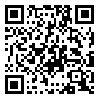

Volume 28, Issue 4 (Autumn 2022)
Intern Med Today 2022, 28(4): 422-433 |
Back to browse issues page
Download citation:
BibTeX | RIS | EndNote | Medlars | ProCite | Reference Manager | RefWorks
Send citation to:



BibTeX | RIS | EndNote | Medlars | ProCite | Reference Manager | RefWorks
Send citation to:
Tehranian F, Nezami H, Maivan M H J, Akbarzadeh Sani J, Hajavi J. Investigating the Frequency of Delta 32 (∆32) Mutation Related to CCR5 Chemokine Receptor in Patients at Gonabad Health Centers, Iran. Intern Med Today 2022; 28 (4) :422-433
URL: http://imtj.gmu.ac.ir/article-1-3932-en.html
URL: http://imtj.gmu.ac.ir/article-1-3932-en.html
Faeze Tehranian1 

 , Hossein Nezami2
, Hossein Nezami2 

 , Mohammad Hossein Jafarzadeh Maivan1
, Mohammad Hossein Jafarzadeh Maivan1 

 , Javad Akbarzadeh Sani3
, Javad Akbarzadeh Sani3 

 , Jafar Hajavi *4
, Jafar Hajavi *4 




 , Hossein Nezami2
, Hossein Nezami2 

 , Mohammad Hossein Jafarzadeh Maivan1
, Mohammad Hossein Jafarzadeh Maivan1 

 , Javad Akbarzadeh Sani3
, Javad Akbarzadeh Sani3 

 , Jafar Hajavi *4
, Jafar Hajavi *4 


1- Infectious Diseases Research Center, Student Research Committee, Gonabad University of Medical Sciences, Gonabad, Iran.
2- Department of Epidemiology and Biostatics, Student Research Committee, Faculty of Health, Mashhad University of Medical Sciences, Mashhad, Iran.
3- Allameh Bahloul Gonabadi Hospital, Gonabad University of Medical Sciences, Gonabad, Iran.
4- Department of Microbiology, Infectious Diseases Research Center, Faculty of Medicine, Gonabad University of Medical Science, Gonabad, Iran. ,hajavi.jaf@gmail.com
2- Department of Epidemiology and Biostatics, Student Research Committee, Faculty of Health, Mashhad University of Medical Sciences, Mashhad, Iran.
3- Allameh Bahloul Gonabadi Hospital, Gonabad University of Medical Sciences, Gonabad, Iran.
4- Department of Microbiology, Infectious Diseases Research Center, Faculty of Medicine, Gonabad University of Medical Science, Gonabad, Iran. ,
Abstract: (2352 Views)
Aims Chemokine receptor type 5 is recognized as the main co-receptor in HIV infection. Many studies have shown that the deletion of 32-base pairs (bp) of both alleles of CCR5 leads to the reduction or elimination of the expression of this gene in immune cells and the natural resistance to HIV infection. This study aims to determine the frequency of delta 32 mutations in healthy people, referring to the health center of Gonabad City, Iran, to focus on finding new treatment methods for the treatment of HIV.
Methods & Materials In this descriptive cross-sectional study, after obtaining ethical approval and informed consent, blood samples were collected from 293 healthy people along with ethylenediaminetetraacetic acid anticoagulant. Genomic DNA extraction was carried out by the kit, and the investigation of delta 32 (∆32) mutation of the CCR5 gene was investigated via the polymerase chain reaction method.
Findings Our results showed that out of 293 people who referred to the health center, 269 people (91.8%) had a healthy gene without mutation (188 bp), 15 people (5.1%) had heterozygous mutations (188 bp and 156 bp), and 9 people (3.07%) had a homozygous mutation on both alleles of CCR5 (156 bp).
Conclusion Based on the results, the homozygous mutation rate of Gonabad Region, Iran, in the studied community is higher compared to similar studies, and more epidemiological and molecular studies are needed for better conclusions.
Methods & Materials In this descriptive cross-sectional study, after obtaining ethical approval and informed consent, blood samples were collected from 293 healthy people along with ethylenediaminetetraacetic acid anticoagulant. Genomic DNA extraction was carried out by the kit, and the investigation of delta 32 (∆32) mutation of the CCR5 gene was investigated via the polymerase chain reaction method.
Findings Our results showed that out of 293 people who referred to the health center, 269 people (91.8%) had a healthy gene without mutation (188 bp), 15 people (5.1%) had heterozygous mutations (188 bp and 156 bp), and 9 people (3.07%) had a homozygous mutation on both alleles of CCR5 (156 bp).
Conclusion Based on the results, the homozygous mutation rate of Gonabad Region, Iran, in the studied community is higher compared to similar studies, and more epidemiological and molecular studies are needed for better conclusions.
Type of Study: Original |
Subject:
Basic Medical Science
Received: 2022/09/12 | Accepted: 2022/11/23 | Published: 2022/09/23
Received: 2022/09/12 | Accepted: 2022/11/23 | Published: 2022/09/23
| Rights and permissions | |
 |
This work is licensed under a Creative Commons Attribution-NonCommercial 4.0 International License. |


